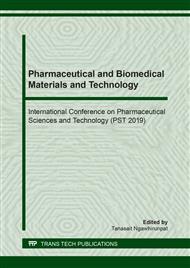p.139
p.145
p.151
p.157
p.163
p.169
p.175
p.181
p.187
Catechol-Bearing Hyaluronic Acid Coated Polyvinyl Pyrrolidone/Hydroxyl Propyl-β-Cyclodextrin/Clotrimazole Nanofibers for Oral Candidiasis Treatment
Abstract:
This research aimed to develop clotrimazole (CT)-loaded mucoadhesive nanofiber patches for oral candidiasis. The three-layered sandwich-like nanofiber patches were prepared by electrospinning technique. The spinning solution for the middle layer composed of 8 %wt polyvinylpyrrolidone (PVP), 90 mM hydroxy propyl-β-cyclodextrin (HPβCD) and 10 % (wt to polymer) of CT in a solvent mixture of ethanol:water:benzyl alcohol. The outer layers were fabricated from a mixture of 1 %wt hyaluronic acid (HA) or catechol bearing hyaluronic acid (HA-cat) and 10 %wt polyvinyl alcohol (PVA) at varied weight ratios. The thickness of the outer layers was varied by adjusting the volume of coating polymer solution ranging from 1 to 3 mL. Desirable smooth nanosized fibers were obtained from the electrospinning process. Increasing the thickness of the outer layer brought about a significant increase in the fiber strength and flexibility. The viscosity of HA-cat/mucin mixture showed good polymer-mucin interaction indicating higher mucoadhesive property of the nanofibers. The drug loading capacity (LC) displayed the potential of the nanofibers for drug encapsulation. The highest LC value of 123.80 ± 5.61 μg/mg was obtained from the nanofibers coated with 1 mL of the coating solution. CT was rapidly released from the nanofiber in the first hour followed by a steady release. The released amount reach above 80% in 2 h. The nanofibers provided superior antifungal activity against Candida albicans compared to CT powder. Moreover, they were found to be nontoxic to the human gingival fibroblast cells. Thus, the sandwich nanofibers may be further developed to be a potential candidate for oral candidiasis treatment in the near future.
Info:
Periodical:
Pages:
163-168
Citation:
Online since:
August 2019
Keywords:
Price:
Сopyright:
© 2019 Trans Tech Publications Ltd. All Rights Reserved
Share:
Citation:


